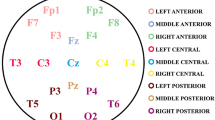Abstract
The aim of the present work was to compare measures of the power spectra, indexes, and coherence of the EEG in term and preterm infants in the first month of life. Six groups of children were investigated, born at 1) 30–32, 2) 33–34, 3) 35–36, 4) 37–38, 5) 39–40, and 6) 41–42 weeks of gestation; there were 10 in each group. The power of the delta frequencies was maximal in group 5. The power of theta frequencies was greatest in group 3. The theta frequencies index was higher in groups 2, 3, and 4. Alpha frequency power was greater in group 2. The index of alpha frequencies was greater in groups 1, 2, and 3. The indexes of beta1 and beta2 frequencies was greater in groups 1, 2, and 4. The largest number of coherence links in the delta, theta, and alpha frequencies were seen in group 6. Group 2, as compared with group 5, had more coherence links in the delta frequencies in the posterior and posterocentral areas, as well as more intrahemisphere synchronization in the theta and alpha frequencies. The results obtained here showed that EEG power spectra, indexes, and coherence depended on the gestation age at the time of birth, though this relationship was nonlinear.
Similar content being viewed by others
References
O. S. Adrianov, V. S. Kesarev, and O. V. Borisenko, “Structural rearrangements of the human cerebral cortex in prenatal and early postnatal ontogenesis,” in: Brain and Behavior in Children [in Russian], O. S. Adrianov (ed.), Institute of Psychology, Russian Academy of Sciences, Moscow (1993), pp. 30–57.
A. S. Batuev, N. N. Iovleva, and A. G. Koshchavtsev, “Characteristics of the EEG power spectrum and coherence structure in full-term and premature children during the first month of postnatal development,” Ros. Fiziol. Zh. im. I. M. Sechenova, 90, No. 3, 294–307 (2004).
L. P. Zenkov, Clinical Electroencephalography with Elements of Epileptology [in Russian], MEDpress-Inform, Moscow (2002).
N. N. Iovleva and V. A. Golubev, “EEG spectral and coherence characteristics in premature children in the first month of postnatal development,” in: Proceedings of the V All-Russian Congress on Prenatal and Perinatal Psychology, Psychotherapy, and Perinatology with International Participation, Through Integration of the Sciences to Preservation of Family Reproductive Health’ [in Russian], Moscow (2005), pp. 160–161.
N. N. Iovleva and D. I. Ivanov, “Characteristics of EEG coherence in premature neonates. Perspectives and Routes to the Development of Pediatric Emergency Care,” in: Annual Interdisciplinary Scientific and Applied Conference of Countries of the CIS [in Russian], St. Petersburg (2006), pp. 156–158.
E. I. Krasnoshchekova, A. S. Samarina, K. N. Fedoseeva, M. A. Ageenkov, and T. Yu. Smolina, “Prenatal ontogenesis of the human cerebral cortex,” in: Proceedings of the XIII International Conference on Evolutionary Physiology [in Russian], St. Petersburg (2006), pp. 117–118.
M. N. Livanov, Spatial Organization of Brain Processes [in Russian], Nauka, Moscow (1972).
V. P. Rozhkov and S. I. Soroko, “Formation of interactions between the wave components of the main EEG rhythms in children in the first five years of life,” Fiziol. Cheloveka, 26, No. 6, 5–19 (2000).
V. S. Rusinov, O. M. Grendel’, and G. N. Bondyreva, Biopotentials in the Human Brain. Mathematical Analysis [in Russian], V. S. Rusinov (ed.), Meditsina, Moscow (1987).
I. A. Skvortsova and N. A. Ermolenko, Development of the Nervous System in Health and Pathology [in Russian], MEDpress-Inform (2003).
D. A. Farber and N. V. Dubrovinskaya, “Structural-functional maturation of the child’s brain,” in: Physiology and Development of the Brain in Children and Adolescents (Theoretical and Clinical Questions) [in Russian], A. A. Baranova and L. A. Shcheplyagina (eds.), Moscow (2000), pp. 5–28.
T. P. Khrizman, Development of Brain Functions in Children. Electroencephalographic Studies [in Russian], Nauka, Leningrad (1978).
A. N. Shapoval’nikov, M. N. Tsitseroshin, and V. S. Ananasionok, Formation of the Human Brain Potential Field [in Russian], Nauka, Leningrad (1979).
A. N. Shapoval’nikov and M. N. Tsitseroshin, “Evolutionary aspects of the establishment of integrative activity in the human brain,” Ros. Fiziol. Zh. im. I. M. Sechenova, 85, No. 9–10, 1187–1207 (1999).
M. Andres, V. M. Andre, S. Nguyen, N. Salamon, C. Cepeda, M. S. Levine, J. P. Leite, L. Neder, N. V. Vinters, and G. W. Mathern, “Human cortical dysplasia and epilepsy: an ontogenetic hypothesis based on volumetric MRI and NeuN neuronal density and size measurements,” Cerebral Cortex, 15, 194–210 (2005).
M. Eiselt, J. Schindler, M. Arnold, H. Witte, U. Zwiener, and J. Frenzel, “Functional interaction within the newborn brain investigated by adaptive coherence analysis of EEG,” Clin. Neurophysiol., 31, No. 2, 104–113 (2001).
V. B. De Graaf-Peters and M. Hadders-Alga, “Ontogeny of the human central nervous system: What is happening when?” Early Human Dev., 82, 257–266 (2006).
M. S. Scher, M. Sun, D. A. Steppe, R. D. Guthrie, and R. J. Sclabassi, “Comparisons of EEG spectral and correlation measures between healthy term and preterm infants,” Pediatr. Neurol., 10, No. 2, 104–110 (1994).
N. S. Scher, D. A. Steppe, D. L. Banks, R. D. Guthrie, and R. J. Sclabassi, “Maturational trends of EEG-sleep measures in the healthy preterm neonate,” Pediatr. Neurol., 12, No. 4, 314–322 (1995).
M. S. Scher, S. G. Dokianakis, M. Sun, D. A. Steppe, R. D. Guthrie, and R. J. Sclabassi, “Computer classification of sleep in preterm and full-term neonates at similar postconceptional term ages,” Sleep, 19, No. 1, 18–25 (1996).
M. S. Scher, D. A. Steppe, R. J. Sclabassi, and D. L. Banks, “Regional differences in spectral EEG measures between healthy term and preterm infants,” Pediatr. Neurol., 17, No. 3, 218–223 (1997).
Author information
Authors and Affiliations
Corresponding author
Additional information
__________
Translated from Rossiiskii Fiziologicheskii Zhurnal imeni I. M. Sechenova, Vol. 93, No. 8, pp. 905–913, August, 2007.
Rights and permissions
About this article
Cite this article
Batuev, A.S., Iovleva, N.N. & Koshchavtsev, A.G. Comparative analysis of the EEG in babies in the first month of life with gestation periods of 30–42 weeks. Neurosci Behav Physi 38, 621–626 (2008). https://doi.org/10.1007/s11055-008-9018-1
Received:
Revised:
Published:
Issue Date:
DOI: https://doi.org/10.1007/s11055-008-9018-1




